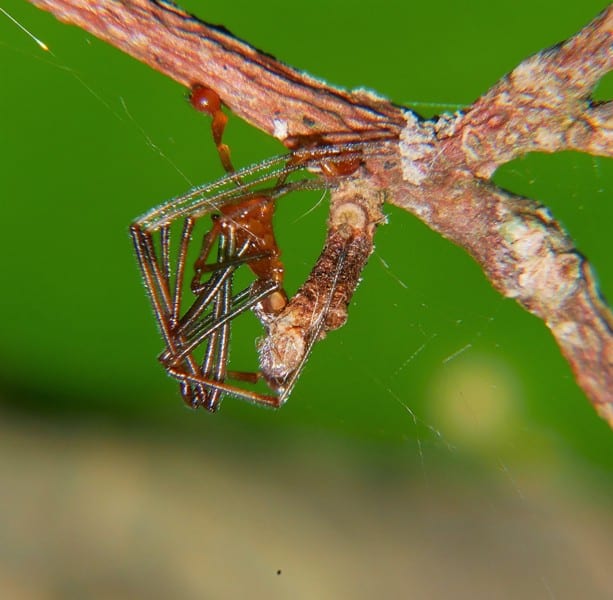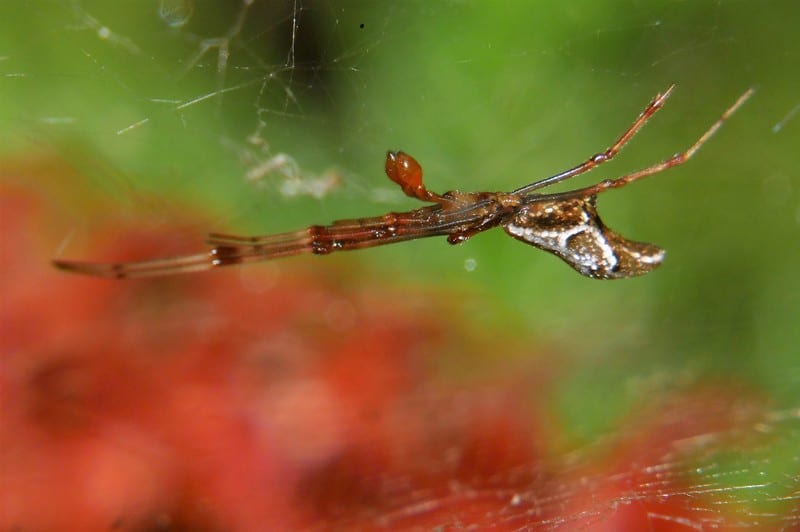Kleptoparasite Spiders
Various


Kleptoparasite Spiders by Steve Pearson
An intricate and complex example of intertwined and inter-dependent life cycles.
Here in the Whitsundays is a diverse series of habitats with a diverse variety of flora, fauna
and fungi. This time we look at a few different types of kleptoparasite (cleptoparasite) spiders.
Kleptoparasite spiders survive by stealing and eating food that is caught in the web of a different
type of spider. There are several different species of LOCAL Whitsunday Kleptoparasite spiders
but the most common genus is Argyrodes from spider family Theridiidae.
One group of Argyrodes kleptoparasite spiders are only a little smaller than their host spider. One example is the tent web spiders Cyrtophora species of family Araneidae. This size group of kleptoparasite Argyrodes have their own web which they build next to the host they plan to rob. They swing around on their own web like a trapeze and then swing onto the tent spider’s web when there is something caught. They quickly wrap it up and anchor it to their own web and then cut it free from the tent spider web and then swing away off on their own web to their own spot to eat what they have stolen.
As you would expect with great diversity, there is the other extreme of very small kleptoparasite
spiders, sometimes called dew drop spiders because they are small and shine like a dew drop.
They live quietly in their own web built into the safer outer edges of the web of the much much larger spiders. Like a mouse in the house, cleaning up and feeding on the catch too small for the big host spider to bother with. This is most common with the big Golden Orb Web spider Nephila species and the Saint Andrews Cross Orb Web spiders, Argiope species of family Araneidae. These each build a large, long term intricate web and work their web repairing as necessary for long periods.
On the other extreme of this is the big kleptoparasite spider, it is so big and bold it is called a
Pirate spider, Australomimetus sp from spider family Mimetidae. It picks on smaller types of spiders and comes onto their web boldly and steals the catch and when the smaller spider rushes out to protect its catch the big kleptoparasite spider Australomimetus species beats it up and eats it. Kleptoparasitism (cleptoparasitism) is very common in the world of spiders and can be observed if you take time to look closely – But! — some kleptoparasite spiders are there but are not easy to find as they find a fine twig and fold themselves up to mimic the twig, thus hidden and not easy to see.
Interestingly, a little spider in a web where there is a larger spider does not always mean the
little one is a kleptoparasite. Some spider species have males that are very small compared to
the female and the little males live in the females web but at a safe distance so it does not get
eaten by her. The little males, (yes there can be more than one hoping to mate with the female)
live quietly feeding off the small catch waiting for an opportunity to mate with the big female without being eaten themselves. Friendly relations and mating usually happens after the female has caught and eaten a big catch. The little Dew Drop Argyrodes can live there in the same web also with both males and females sharing the hosts web. The Argyrodes species also mate after good feeds and then the female leaves and finds a secret place to create an unusual upside down urn shaped egg sack that she fills with eggs. Even as small as the Dew Drop Argyrodes are, and their egg sacks with such a small tunnel entrance so small, there are still even smaller, minute parasitoid wasps that deposit their own eggs inside which feed on the spider eggs and……
……..out emerges the wasps.
| Classifications: | Arachnid |
| Family: | Theridiidae |
| Information sources: | Steve Pearson |



